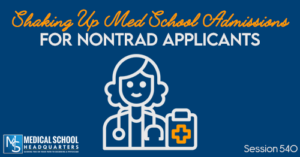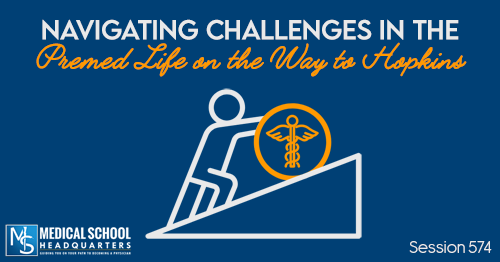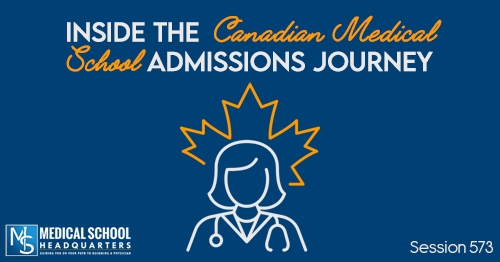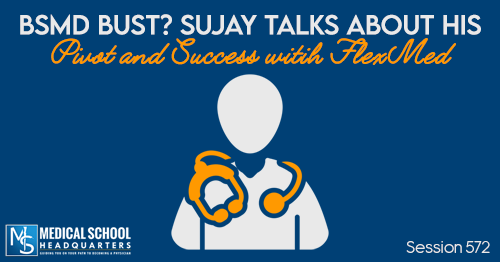Apple Podcasts | Google Podcasts
Session 540
Today, we speak with Deana Golini, a former admissions officer at Stanford Medicine and current advisor at MSHQ, about a variety of topics. We talk about her path into medical school admissions and advising and some help for some nontrads and all premeds out there.
For more podcast resources to help you with your medical school journey and beyond, check out Meded Media.
Listen to this podcast episode with the player above, or keep reading for the highlights and takeaway points.
[01:22] The MCAT Minute
The MCAT Minute is brought to you by Blueprint MCAT. Sign up for their free account, which has so many amazing free resources like the half-length diagnostic, a full-length exam, their amazing study planner tool and so much more.
[02:09] Deana’s Background
Deana’s experience primarily revolves around her roles as an educator, counselor, and advocate for students. As a high school guidance counselor, her passion for the college admissions process grew, especially when witnessing the success of first-generation and less-informed students securing acceptance into universities.
Deana became a valued member of Brown University’s inaugural counselor advisory board, representing Rhode Island. She provided her expertise in crafting supplemental questions and offering feedback on the admissions process.
Her Passion for the Medical School Realm
In addition, Deana mentored a graduate intern from Providence College, who later recommended her for a part-time position in premed advising at Northeastern University. Recognized for her exceptional writing skills, Deana eagerly embraced the chance to learn how to write committee letters and discovered her passion for the medical school realm.
For her, while undergraduate admissions can certainly be fulfilling and impactful, the medical school admissions process offers a unique set of challenges and complexities.
It’s refreshing to be able to dive into the intricacies of medical school admissions and help students who are passionate about STEM and science achieve their dreams. The opportunity to guide and support these students on their journey towards becoming future doctors is truly rewarding.
[05:12] Advising Role for Nontrad Students
Deana’s experience at Alpert Medical School was a transformative journey for her. After dedicating 23 years to a career in public education, she made the bold decision to step into a new role as the Assistant Director of advising students and outreach for the Masters of Medical Sciences program at Brown University. This program, embedded within the Warren Alpert Medical School, consisted of a small cohort of about 35 students who immersed themselves in a rigorous one-year curriculum alongside medical students.
In her role, Deana had the opportunity to continue advising and supporting students, working closely with them on their applications and committee letters. The students she worked with were often those who thought they couldn’t pursue a career in medicine. Some had experienced setbacks in previous application cycles or had made major career transitions, such as shifting from engineering to medicine. Many of these students came from underrepresented backgrounds.
The experience was immensely rewarding for Deana as she witnessed the incredible results that can be achieved with the right guidance, support, and program. It proved that non-traditional students have the ability to overcome obstacles and succeed in their pursuit of becoming doctors. The impact she made in helping these students realize their dreams left a lasting impression on Deana. It reinforced her belief in the power of advising and support in the medical school admissions process.
“With the right advising, the right support, and the right program, nontraditional students can definitely get there.”Click To Tweet[07:23] What Makes a Successful SMP Student
A successful SMP (Special Master’s Program) student is one who fully utilizes the resources and opportunities provided by the program.
These students understand the value of seeking guidance from advisors, mentors, professors, and faculty members. They recognize the importance of relearning effective study habits, especially if they have been out of school for an extended period.
Adapting to the rigorous pace of classes like brain science or microbiology helps them understand the demands of medical school.
The Power of Community and Relationships
Additionally, successful SMP students take advantage of community connections. Many programs offer capstone projects that allow students to work with free clinics or federally qualified healthcare centers. This provides them with valuable research experience and an opportunity to partner with clinicians to develop essential skills. By making the most of these community connections, students can broaden their knowledge and gain practical experience.
Another key aspect of success for SMP students is forming relationships with those who can support them in the application process. For instance, the program may facilitate the generation of a committee letter, which can be beneficial for students who have been out of school for a long time and struggle to obtain recommendation letters. By building strong relationships with professors and faculty members, students create a network of supporters who can vouch for their abilities and potential as future medical professionals.
“Forming relationships with all of those people who can support you, in the process, when you apply is really important.”Click To TweetChoosing the Right SMP for You
When it comes to choosing the right program, conducting thorough research is essential. With numerous programs available, it’s important to clarify your goals and preferences.
Do you prefer a small cohort or a larger student body? Would you like MCAT preparation integrated into the program? Are clinical and research opportunities important to you alongside academics?
These are just a few factors to consider as programs can vary significantly. The key is to carefully weigh your options and select a program that aligns with your individual needs and aspirations.
[10:08] Her Transition From Alpert to Stanford
After dedicating 23 years to the field of education, she felt a strong desire to explore new opportunities and expand her knowledge.
With a background in advising and supporting students, Deana was curious about the admissions process. She wanted to contribute her insights to the evaluation of applications. She sought to bridge the gap between student perspectives and the admissions side, ensuring that the experiences and concerns of applicants were taken into account.
Deana’s non-traditional background working with diverse student populations provided her with a unique perspective in evaluating applications and identifying exceptional candidates. Her transition to Stanford allowed her to continue making a meaningful impact in higher education.
[12:33] Behind the Scenes in the Admissions World
A Complex Production
Behind the seemingly seamless admissions process lies a massive production. It can be likened to orchestrating the Macy’s Thanksgiving Day Parade, where everything appears splendid to the viewers. However, the amount of work that goes on behind the scenes is daunting. Countless procedural and operational tasks must be meticulously executed to ensure that everything runs smoothly.
Facilitating the Acceptance Process
When a student receives that coveted phone call of acceptance, the next steps are crucial. They expect to access their acceptance letter through their online portal, navigate financial aid forms, and arrange for transcript submissions.
These seemingly small details require extensive coordination to ensure that newly accepted students are seamlessly integrated into the system. It involves liaising with various departments, such as finance and admissions, to ensure that all relevant information is properly communicated.
“There's so much that goes on behind the scenes…. Admissions is a busy place.”Click To TweetThe Busy Nature of Admissions
Admissions offices, both at the undergraduate and graduate levels, are bustling places. The demand for efficiency leaves little time for other activities or outreach initiatives.
Building strong connections with premed advisors and prospective students often gets overlooked due to limited resources and time constraints. This absence of transparency and connection can sometimes create the impression that there is an inaccessible team operating from an ivory tower, which is far from reality.
Intentions and Resource Constraints
The lack of proactive outreach to advisors and pre-med students may not necessarily be intentional to keep secrets. Instead, it is often a consequence of being under-resourced and stretched thin.
'At the end of the day, admissions wants to find future doctors. They're excited to read applications... but there's just not a lot of time.'Click To TweetAdmissions teams have numerous responsibilities and deadlines to manage, leaving little room for extensive outreach efforts. While the desire to establish connections and answer questions is present, the practical constraints make it challenging to fulfill.
[15:34] What Holistic Admissions Is
Misconceptions and Holistic Admissions
One of the common misconceptions among students is the term “holistic admissions.” Some may believe that having a lower GPA or MCAT score can be compensated by strong extracurricular activities. They assume that because institutions claim to practice holistic admissions, they will still have a fair chance. However, this may not always be the case.
What is Holistic Admissions?
Holistic admissions, at its core, means considering the entirety of an applicant’s profile. It involves evaluating all the information provided in the application package, including stats, experiences, background, personal story, writing samples, and science aptitude, among other factors.
Admissions committees take a comprehensive approach to understand and assess applicants as individuals.
The Role of Stats in Holistic Admissions
While holistic admissions look beyond grades and test scores, it does not dismiss their importance entirely. Admissions committees recognize the significance of academic performance and standardized tests, particularly in fields like science.
The reason behind this is the recognition that rigorous education awaits admitted students. Institutions want to ensure that applicants can handle the challenging science curriculum and successfully complete their studies.
'At the end of the day, you still have to complete a really demanding and rigorous education… and admissions needs to know that you're going to be able to do it.”Click To TweetBalancing Risk and Potential
When considering applicants with lower stats, such as a 2.9 GPA and a 480 MCAT score, admissions committees must weigh the potential risks and the likelihood of success. They take into account the applicant’s ability to navigate a demanding curriculum and fulfill the requirements of their chosen program.
It becomes essential to assess whether the applicant has demonstrated sufficient proficiency in science coursework or if they might require additional resources and support to succeed.
[17:37] Considering Fit in Medical School Admissions
During a conference conversation with deans and directors of admissions, the topic of fit for students with varying academic profiles arose.
If a student has a GPA in the range of 3.4 to 3.5 and a lower MCAT score, it may indicate that they could require additional support throughout their medical school journey, especially during the preclinical years.
Each school understands its available resources and determines whether they can effectively support such students. Schools lacking the necessary resources or success in providing support might suggest that the student seeks another institution that can better accommodate their needs.
Finding the Right Fit
It is crucial for students to recognize that not every medical school will be a perfect fit for them. Just as in life, where one may not thrive in every job or relationship, there will always be a place that suits their goals and aspirations. Understanding this reality can help students approach the admissions process with a more open mindset.
'You're not going to be a fit at every single medical school... and that's okay.'Click To TweetAlignment with School Mission
The concept of fit also extends to the mission of the school. Some institutions have a strong focus on research and scholarly projects, which is reflected in their mission statements.
In such cases, if an applicant lacks any research experience or background, they may not align with the vision and direction of the school. It is essential for applicants to consider whether their own goals and values align with those of the institution they are applying to.
[19:39] Showing Research Potential in Your Application
During a conversation with an admissions committee member, possibly from UCSF at the UC Davis conference, a differing view on the importance of research for applicants emerged. While big, academic, research-heavy institutions may expect a significant research background from their students, it is not always the only factor considered.
Admissions committees, depending on the institution, may or may not actively seek alternative indicators of research potential. There are certainly ways to gain research experience outside of traditional academic settings. For example, working at a women’s clinic and recognizing the need for improved lactation education could inspire you to conduct your own research.
By engaging with patients, gathering quantitative data on their experiences, and compiling your findings, you can contribute to the field, even if it may not be considered academic research.
Time Constraints in the Admissions Process
The admissions process faces significant time constraints, especially when dealing with large applicant pools. While it would be ideal to thoroughly review each application and seek out research experience, volunteer work, or impactful contributions, the reality is that there simply isn’t enough time for such extensive evaluations. With thousands of applications to consider, admission committees have to prioritize and make decisions efficiently.
[22:02] Interpreting MCAT Scores and the MSAR
When students refer to the Medical School Admission Requirements (MSAR) and come across median MCAT scores such as 517 or 518, it can be intimidating if their own score falls below the 10th percentile, like a 510. However, it’s important not to let these numbers discourage you.
The median MCAT scores listed in the MSAR are indeed averages, and they should not be the sole determining factor in your decision-making process. Admissions committees evaluate applications holistically, taking into account various aspects such as academic achievements, extracurricular activities, personal statements, and letters of recommendation.
It’s crucial to remember that exceptional candidates exist who possess the potential to make a significant impact on the world, despite having MCAT scores well above or below the mean. If you believe that you are a good fit for a particular school and its program, and if your values align with their mission, then don’t let a single metric overshadow your overall potential.
Hyper-focusing on MCAT scores alone may not be productive or beneficial. Instead, concentrate on presenting a well-rounded application that highlights your strengths, experiences, and dedication to the field of medicine.
[24:03] The Call for Transparency
Transparency in medical school admissions, specifically regarding the information provided by the MSAR, is a topic of concern for many applicants. While the MSAR does provide data such as median MCAT scores and GPAs, it falls short in providing specific minimum score requirements for each school. This lack of clear-cut criteria can make the application process more stressful and uncertain for students.
The addition of mean and standard deviation to the MSAR’s data is a step towards increased transparency, as it provides a broader understanding of the applicant pool. However, it still does not address the need for clear minimum score requirements that would streamline the process and alleviate stress for applicants.
One possible explanation for the limited transparency could be the funding sources of these institutions. State-funded medical schools in California, Texas, or Florida, for example, might have more uniform criteria due to their shared funding structure. However, private institutions or those with different funding models may have varying criteria, making it more challenging to establish standardized guidelines.
[26:55] Evaluating Applicants and Making an Impact
Deana, in her role in admissions, was driven by this curiosity about how to find and evaluate standout applicants from a pool of 9000 applications. She believes that these exceptional individuals would not only be amazing doctors. But they would also align with the mission and values of the specific medical school they were applying to.
It’s not about the “x factor,” but it’s more of a chain, a connection between the applicant and their potential to be agents of change and make a significant impact in the world.
For Deana, it was crucial to assess the impact the applicants had already made and determine how much they could contribute to the medical school community and society as a whole. She continually seeks to foster their desire to go out into the world and create positive change.
Deana firmly believes that accepting an applicant meant recognizing their potential to make a real difference once they walked out the doors of the medical school.
'Just going the extra mile and really taking things to another level – not just showing up.'Click To TweetA lot of premed students think they just have to check the box. When you’re looking at admissions it’s just the bare minimum compared to students who didn’t just show up.
[32:14] On Writing Personal Statements
Deana, with a strong background in English and humanities, emphasizes the importance of the personal statement in the application process. She believes that this piece of writing was the only part of the application where the applicant’s voice truly shines through.
While statistics, transcripts, and recommendation letters provide valuable information, the personal statement allows the applicant’s authenticity to come forward. The personal statement showcases the applicant’s unique perspective and personal experiences, giving admissions committees a glimpse into their individuality.
Furthermore, Deana recognizes that writing skills are essential for success in medical school. The personal statement serves as a way for schools to assess an applicant’s ability to communicate effectively through writing.
Moreover, research projects and other academic tasks in medical school would require substantial writing. Therefore, it’s crucial for applicants to demonstrate their proficiency in this area.
“The piece of writing that you are presenting is in your voice and authenticity has to shine through.”Click To Tweet[33:22] Balancing Authenticity and Guidance: Helping Applicants Craft Spectacular Personal Statements
When advising and providing feedback on personal statements, one of the key challenges is finding the right balance to ensure that the applicant’s voice remains true to their own unique story.
As an advisor, Deana’s role involves extracting the essence of someone’s narrative. She assists them in exploring different perspectives they may not have considered before. While an applicant may have initially presented a straightforward story, she aims to dig deeper, uncovering additional layers of meaning and significance.
By guiding students along this path, she can help them recognize how their experiences have truly transformed their lives and shaped who they are today. It is through these discussions and explorations that we work together to develop a personal statement that surpasses their initial expectations, resulting in a truly spectacular composition.
[34:41] The Interview Process
Drawing from her experiences at Brown, Deana conducts numerous mock interviews with students. And she understands the importance of helping them become comfortable with discussing and selling themselves.
Deana believes that conveying one’s thoughts and being personable is among the most challenging aspects of interviews. She recognizes that schools aim to evaluate applicants’ suitability for their programs and identify any potential red flags. Effective communication, the ability to articulate ideas, and ethical judgment are key factors that schools assess during the interview process.
In addition, Deana emphasizes the necessity for applicants to think on their feet, as being a doctor requires quick thinking and adaptability. The interview provides a platform to gauge an applicant’s ability to navigate situational judgment tests and showcase their capacity for immediate response.
'The interview is a great tool to just get to know an applicant.'Click To TweetDeana views the interview as a powerful tool for getting to know applicants on a deeper level. It allows schools to assess candidates beyond what is presented on paper, as some individuals may appear differently in person or on camera. The interview gives applicants the opportunity to let their personalities shine through, enabling charismatic and personable individuals to leave a lasting impression.
[36:14] Thoughts on Virtual Interviews
Organizing interview day involves a significant amount of legwork. It’s not just the admission staff conducting the interviews; it also involves finding faculty, staff, professors, and alumni to participate. Coordinating the schedules of these individuals, many of whom have demanding schedules due to their involvement in medicine and travel commitments, can be quite challenging.
Easier Logistics
Deana believes that virtual interviews have made the logistical aspects of the process much easier. With virtual interviews, there is no need for extensive travel arrangements or coordinating in-person meetings. This simplifies the process and reduces the burden on both the applicants and the interviewers.
Increased Equity
One major advantage Deana sees with virtual interviews is increased equity for the applicants. Students from all over the world, representing various time zones, have the opportunity to interview without the added expenses of travel and accommodation. This levels the playing field and ensures that all applicants have equal access to the interview process, regardless of their location or financial circumstances.
[39:28] Final Words of Wisdom
Deana advises students to take advantage of all available resources, particularly the free materials provided by MHSQ. She emphasizes the importance of seeking guidance and support throughout the med school admissions process, as many unsuccessful students often lack proper advising and advice. With the intricacy involved in admissions, having someone to help navigate the process is crucial for success.












